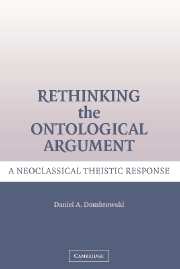Book contents
- Frontmatter
- Contents
- Acknowledgments
- Introduction
- 1 Historical Background
- 2 Poetry versus the Ontological Argument: Richard Rorty's Challenge
- 3 Deconstructionism and the Ontological Argument: The Case of Mark Taylor
- 4 Is the Ontological Argument Worthless? Graham Oppy's Rejection
- 5 Oppy, Perfect Islands, and Existence as a Predicate
- 6 Rival Concepts of God and the Ontological Argument: Thomas Morris, Katherin Rogers, and Alvin Plantinga
- Bibliography
- Index
1 - Historical Background
Published online by Cambridge University Press: 16 July 2009
- Frontmatter
- Contents
- Acknowledgments
- Introduction
- 1 Historical Background
- 2 Poetry versus the Ontological Argument: Richard Rorty's Challenge
- 3 Deconstructionism and the Ontological Argument: The Case of Mark Taylor
- 4 Is the Ontological Argument Worthless? Graham Oppy's Rejection
- 5 Oppy, Perfect Islands, and Existence as a Predicate
- 6 Rival Concepts of God and the Ontological Argument: Thomas Morris, Katherin Rogers, and Alvin Plantinga
- Bibliography
- Index
Summary
A Brief History up until Anselm
This part of the book will be devoted to putting some flesh on the bones of the three key moments in the history of the ontological argument. The purpose of this history is obviously not to do an exhaustive survey of the historical uses of the argument, nor even to do original historical research of some more attenuated sort. Rather, I would like to sketch a history of the ontological argument so as to set the stage for my treatment of the six contemporary authors who are focus of the present book. As with many other topics in philosophy, current thinking about the ontological argument involves historical thinking in that the various concepts employed in discourse about the argument (concepts such as that there is that than which no greater can be conceived, perfection, existence as a predicate, necessity v. contingency, etc.) carry with them rich historical resonances (or baggage).
I should begin, I suppose, with Anselm, but there is good reason to think that although he was the first to state the argument explicitly, it is implicit in several earlier thinkers: Plato (Johnson 1963; Dombrowski 2005, Ch. 5; Halfwassen 2002; Mesquita 1994; Ceniza 2003), Philo and the Neoplatonists (Beckaert 1967; Oppy 1995, 101–105, 274–275), Avicenna (Rescher 1960; Morewedge 1970), and others.
- Type
- Chapter
- Information
- Rethinking the Ontological ArgumentA Neoclassical Theistic Response, pp. 7 - 31Publisher: Cambridge University PressPrint publication year: 2006



